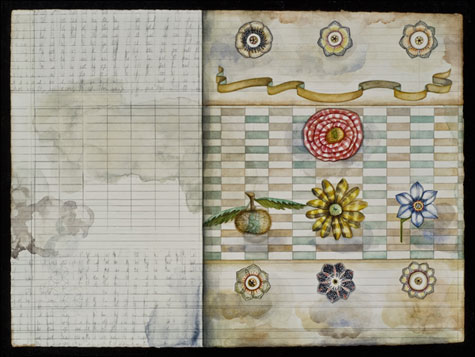
REFRESHING SURPRISE: A Gail Spaien painting. |
Here in Maine we're used to living in a mediated landscape. Painters have been reframing how we see the shore and woods for generations, defining what's worth looking at for a larger audience. Think of Winslow Homer on Prouts Neck, for instance, creating his wonderful fictions for the folks back in Boston.So it's no surprise that the Institute of Contemporary Art at the Maine College of Art would hit on such a theme as they planned a faculty show. This year they've opted to forgo the habitual dreary salon-type big group and go instead to smaller groups with a more sharply defined curatorial selection.
These days the pressure in schools is for capital-R Relevance, and here we have four installations, three of which have leanings in that direction, while the fourth is rooted in that other art-world favorite, pop culture.
Christina Bechstein has assembled exactly the same number of pressed-paper produce containers as there are people living on the Portland peninsula: 23,404. These are arranged in a big series of stacks filling much of the big ICA exhibition space. The stacks vary in height, making an arrangement that exists in tension with the ideas expressed in her artist's statement. The statement relates the work to our collective authorship of "waste, coupled with the hunger crisis both globally and locally." The installation needs the statement to articulate these ideas. By themselves the boxes can seem a purely formalist exercise without specific content.
George LaRou shows a simple video game that features a piece of land with a beaver, a hunter, a logger with a chainsaw, a river, and a few trees. I confess I didn't have the patience to learn how to play the game, although I did play with the controllers a bit. The hunter tries to shoot the beaver and the logger cuts down the trees. One of the buttons says "spit," but it wasn't clear who was expectorating — maybe the beaver? The graphics were neat and there's probably a game to be developed here, but I did feel I was being spoon-fed more Relevance.
Phillip Brou shows two pieces based on tornado chambers, one built firmly with glass window, the other inflatable, both a few feet high. Tornado chambers are machines that simulate the action of a tornado. In the glass structure, little portraits from Brou's high-school class swirl around in the wind. In the inflatable chamber there's a little house suspended from the top that swings about. We learn from the wall text that it's a scale model of Dorothy's farmhouse from the movie version of The Wizard of Oz.
Gail Spaien shows a group of six gouache paintings that serve as the conceptual anchor of a larger installation. The paintings are imaginary renderings that echo old botanical illustrations. The rest of the room is filled with large amaryllis plants arranged in regular rows, and there are a series of six plexiglass boxes hung on the wall beside the paintings, each filled with what appears to be dried plant material.
To my eye those six paintings were the most resonant objects in the show. They're mysterious, self-contained, and suggestive without being literal. The rest of Spaien's presentation seemed to expand on the ideas in the paintings for didactic purposes. This is a college, after all, and explanations are, I suppose, a necessary protocol.